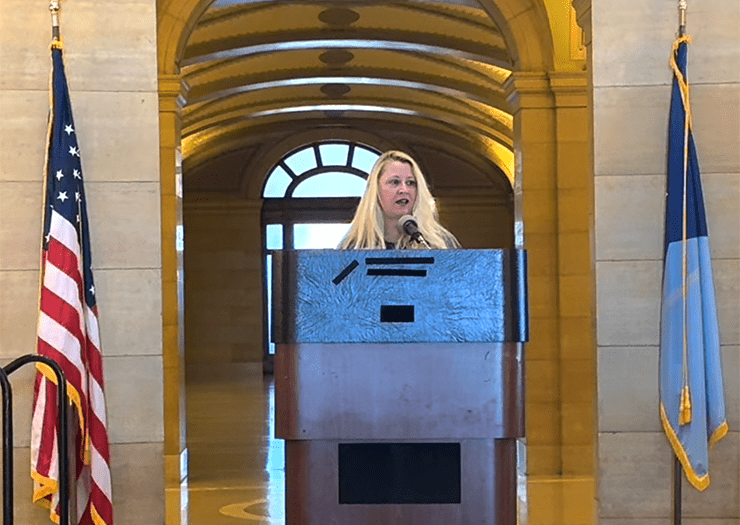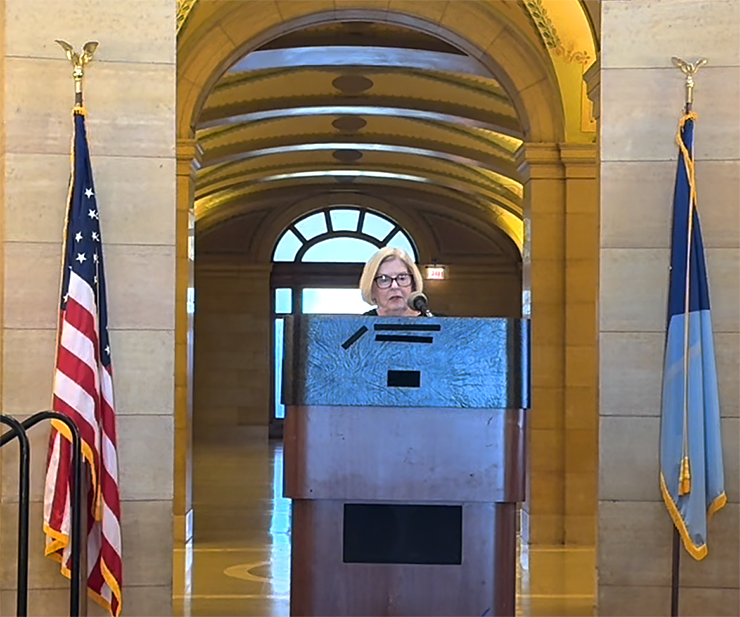Around the United States, there are people in households that make enough income to sit above the federal poverty level, but not enough to afford the basic costs of living.
These households are ALICE households – an acronym standing for asset limited, income constrained and employed.
Representatives from various United Way organizations – Greater Twin Cities United Way, United Ways of Minnesota and United for ALICE – along with Children’s Minnesota, gathered to announce the release of ALICE in Minnesota: A Study of Financial Hardship at the Minnesota State Capitol on Tuesday. The research, conducted by United Ways of Minnesota and United for ALICE, shows how many households in Minnesota qualified as ALICE households from 2010 to 2022, the most recent year for which there is census data. According to the report’s data, there were more than 600,000 households in Minnesota who were ALICE – living above the federal poverty level, but unable to meet the basic cost of living within their counties.
What/who is ALICE?
ALICE as a metric was born out of a study done by United Way of Northern New Jersey in Morris County and is different from the federal poverty level in that it is not country wide but county wide.
“(The) ALICE budget threshold is a number that is calculated using the expected costs of housing, food, transportation, health care, child care (and) technology,” explained Erin Flicker, director of impact strategy and execution at Greater Twin Cities United Way.
The federal poverty level is determined based on price changes of goods in the Consumer Price Index. Where this falls short, according to United for ALICE, is that the Consumer Price Index covers not just essential goods, but more than 200 goods and services and does not account for differences in cost of living around the country, besides in Alaska and Hawaii.
“On average for the state of Minnesota, a household of four with two adults and two small children would require $77,000 to be at that survivability level,” said Michelle Roers, senior vice president of ALICE strategy at United Way of Northern New Jersey. “And they’re not able to get by. At the stability level for that same family of four, it would require an income of $132,900. It might seem like a lot of money, but when you’re trying to put two small children through child care (and) support a family, it’s quite difficult. And remember, that’s a combined household income of two working parents.”
 “On average for the state of Minnesota, a household of four with two adults and two small children would require $77,000 to be at that survivability level,” said Michelle Roers, senior vice president of ALICE strategy at United Way of Northern New Jersey. Credit: MinnPost photo by Deanna PistonoThe benefits cliff
“On average for the state of Minnesota, a household of four with two adults and two small children would require $77,000 to be at that survivability level,” said Michelle Roers, senior vice president of ALICE strategy at United Way of Northern New Jersey. Credit: MinnPost photo by Deanna PistonoThe benefits cliff
Being an ALICE household has put people in situations where they need support from public assistance programs, but are often unable to access these programs due to income qualifications.
“The majority of programs that are available throughout the state still use federal poverty guidelines or the federal poverty level for eligibility,” said Flicker. “Knowing that (the federal poverty line is) an outdated metric, we’ve done a multiplication of the federal poverty guidelines, so (it’s) 200% or 300% for eligibility (in various programs). But when we’re talking about counties that have such significant variance in what you need to survive, having a flat number of eligibility throughout the state really misses a significant portion of the state.”
At the 211 call center where United Way personnel connect people with assistance, including housing and food support, referrals can be challenging for people who are ALICE, specifically because they don’t qualify for programs that use the federal poverty level to determine eligibility, such as SNAP. When households used to qualify for programs but no longer do, Flicker describes the loss of benefits that occurs as “hitting the benefits cliff.”
“Once they are no longer below that expected (income) cutoff (for programs), they become an ALICE family, where they’re still not getting enough income to make their ends meet, but they’re no longer eligible for those programs,” said Flicker. “I’ve (recently) talked with a parent, a mom who had been receiving daycare benefits. She received a 15 cent raise at work, which put her income over eligibility. The 15 cent raise increased her income by maybe a hundred bucks a month, but she lost several hundred dollars in daycare benefits. So she’s actually worse off as a result.” Flicker later stated via email that the amount of the raise and the resulting wage increase were not exactly what they had specified.
Disparities
In Minnesota, the counties with the greatest percentage of households below the ALICE threshold – who are either ALICE or under the federal poverty level – are Mahnomen County (54%) and Aitkin (46%), along with Wadena and Todd (both 44%). People in certain professions are more likely to live in ALICE households than others, with personal care aides, registered nurses, nursing assistants and retail salespeople having some of the highest percentages of households below the ALICE threshold in Minnesota.
There are also disparities with regards to which households are more likely to be within the ALICE threshold. While around 34% of Minnesota’s white households are under the ALICE threshold, around 60% of Black Minnesotan households, around 58% of American Indian/Alaskan Native households in Minnesota and around 45% of Hispanic Minnesotan households fall within the ALICE threshold. Households led by single mothers are also more likely to be ALICE, said Roers, with 72% of these households below the threshold.
What comes next?
Now that this data has been released to the public, the hope of those involved in its collection is it is used to create meaningful change.
“We’re giving all of this data away,” said Doris Pagelkopf, executive director of United Ways of Minnesota. “We want government, businesses, towns, cities (and) every organization to use this data. How can we come together to make some changes to lift up the ALICEs in Minnesota, because we have 600,000 ALICEs in Minnesota? That’s a lot of people.”
 Doris Pagelkopf, executive director of United Ways of Minnesota: “We want government, businesses, towns, cities (and) every organization to use this data. How can we come together to make some changes to lift up the ALICEs in Minnesota, because we have 600,000 ALICEs in Minnesota? That’s a lot of people.” Credit: MinnPost photo by Deanna Pistono
Doris Pagelkopf, executive director of United Ways of Minnesota: “We want government, businesses, towns, cities (and) every organization to use this data. How can we come together to make some changes to lift up the ALICEs in Minnesota, because we have 600,000 ALICEs in Minnesota? That’s a lot of people.” Credit: MinnPost photo by Deanna Pistono
Roers shared an example from Michigan as to how ALICE data is shaping policy.
“(Michigan has) actually been using the ALICE data to drive some of their work, particularly around their initiatives to reduce poverty. In Michigan, for their fiscal year 2023, they proposed and actually did pass tripling their earned income tax credit, (which) lifted 22,000 Michigan residents out of poverty. They also used it to drive the building and preservation of over 75,000 affordable housing units and also boosting access to affordable child care.”
 “ALICE data will help us be better health care providers for all children in the state,” said James Burrough II, senior vice president of government and community relations and chief equity and inclusion officer at Children’s Minnesota. Credit: MinnPost photo by Deanna Pistono
“ALICE data will help us be better health care providers for all children in the state,” said James Burrough II, senior vice president of government and community relations and chief equity and inclusion officer at Children’s Minnesota. Credit: MinnPost photo by Deanna Pistono
“ALICE data will help us be better health care providers for all children in the state,” said James Burrough II, senior vice president of government and community relations and chief equity and inclusion officer at Children’s Minnesota. “Eighty percent of what happens to kids in their health care journey happens outside of our hospital setting. Those things are called the social determinants of health. That’s employment, that’s education, that’s food deserts in the neighborhood, that’s climate that’s happening in the neighborhood, that’s the culture in which you’re raised. The hospital can only respond to 20%. So imagine if that ALICE data (we) talk about can help change that 80%. It could change the world for those kids.”
Editor’s note: Additional language was added to clarify that values of a raise and resulting wage increase were not exact.

Related
Source link : http://www.bing.com/news/apiclick.aspx?ref=FexRss&aid=&tid=66e2bb2f87374c4983ea17b5e404cf34&url=https%3A%2F%2Fwww.minnpost.com%2Frace-health-equity%2F2024%2F09%2Fwith-no-help-from-the-state-or-federal-government-minnesota-alice-households-are-struggling%2F&c=958034797250941272&mkt=en-us
Author :
Publish date : 2024-09-11 08:00:00
Copyright for syndicated content belongs to the linked Source.